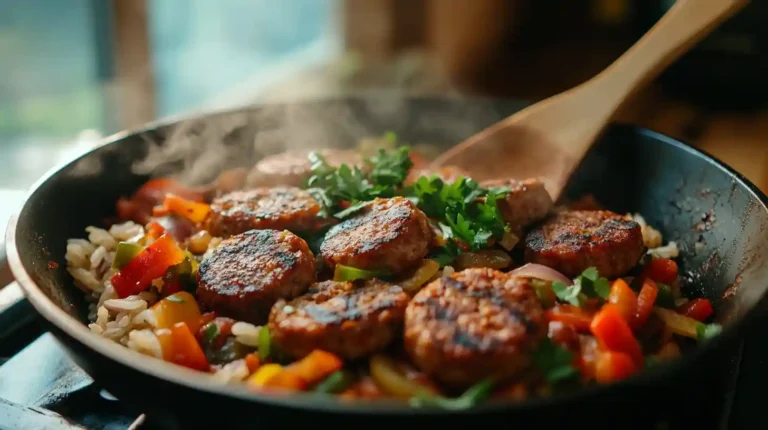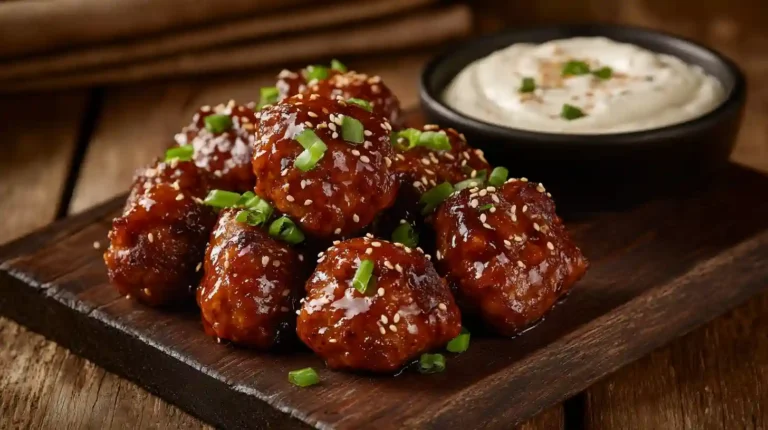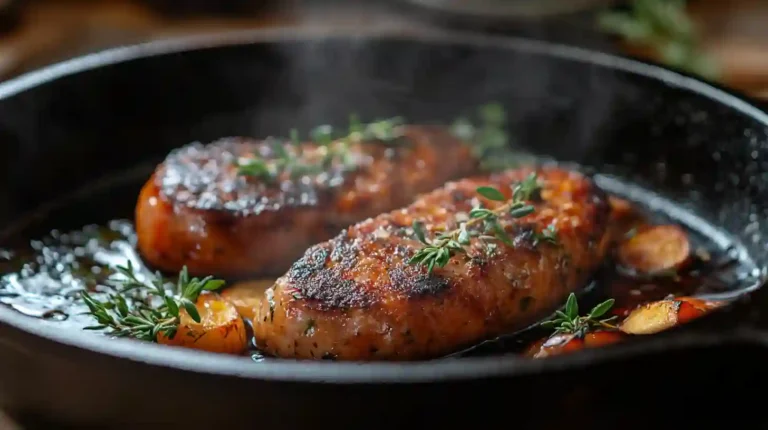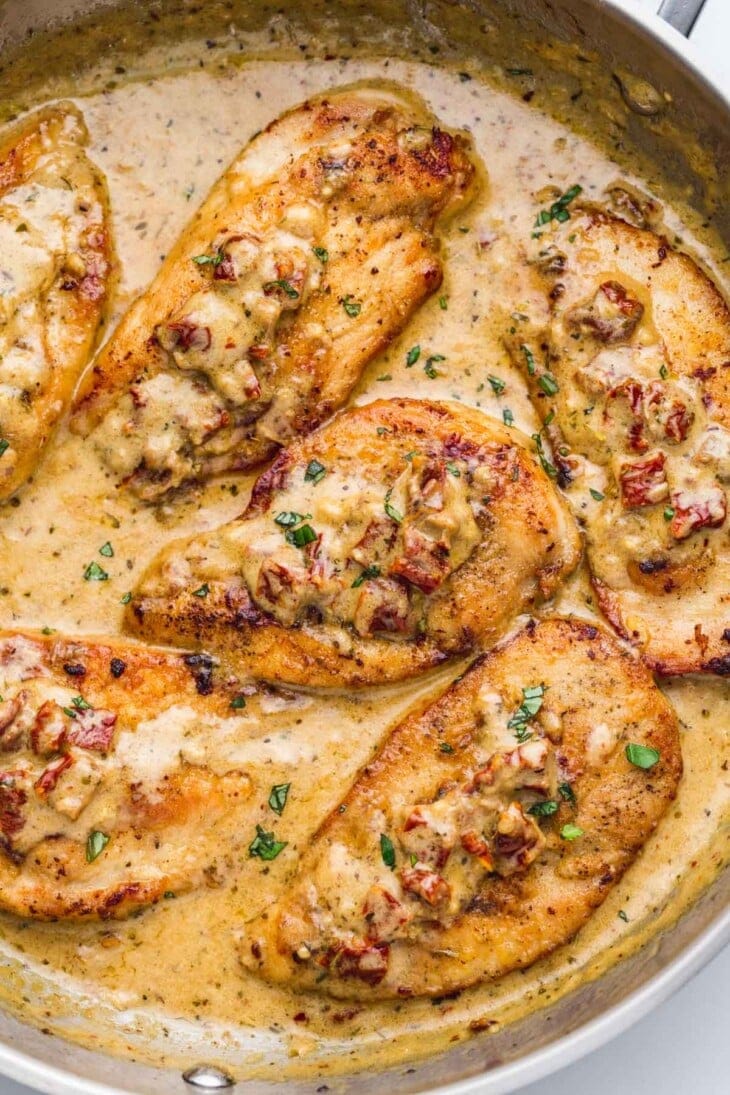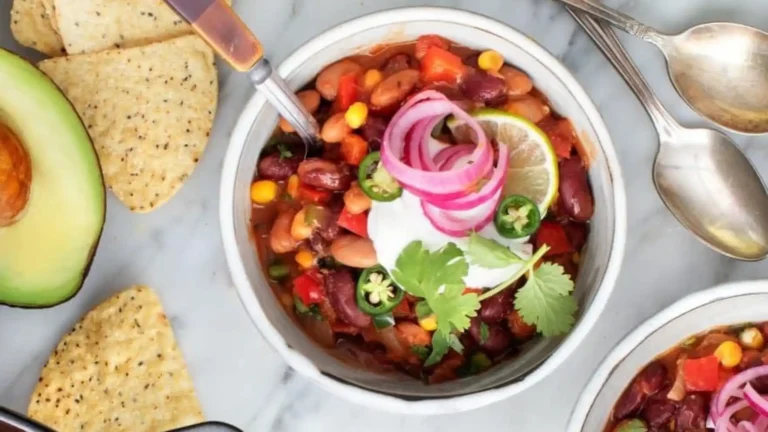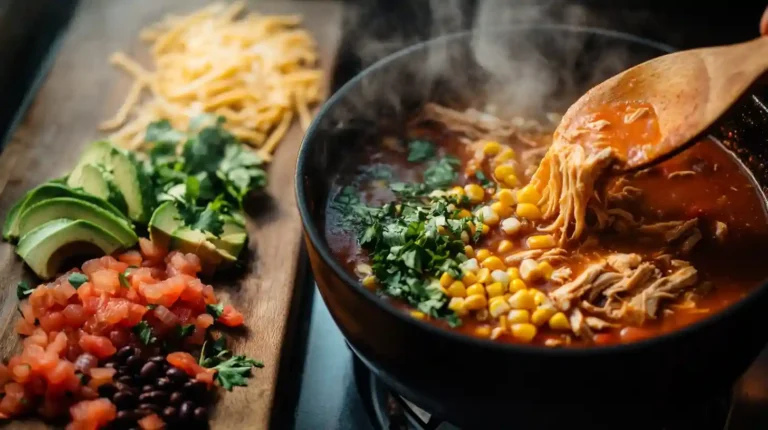Easy Beef Ribeye Roast Recipe: Perfectly Juicy Every Time!
A ribeye roast is a show-stopping centerpiece, perfect for special occasions or an indulgent family dinner. Known for its rich marbling, this cut of beef delivers unmatched tenderness and deep, buttery flavor when cooked properly. Whether you prefer a bone-in ribeye roast for extra juiciness or a boneless ribeye roast for easy slicing, this recipe will guide you through achieving a perfectly roasted, mouthwatering ribeye every time.
Unlike prime rib, which is often associated with restaurant-quality feasts, a ribeye roast is a more accessible and equally flavorful cut that you can prepare effortlessly at home. Cooking it low and slow in the oven allows the fat to render beautifully, creating a juicy, tender roast with a crispy, flavorful crust.
In this recipe, you’ll learn the best seasoning blend, the ideal cooking time per pound, and expert techniques to ensure your roast is perfectly medium-rare or well-done depending on your preference. Follow along for a foolproof way to make a restaurant-quality ribeye roast right in your own kitchen.
Key Benefits
Cooking a ribeye roast at home offers several advantages, from cost savings to total control over flavor and doneness. Whether you’re preparing it for a holiday feast or a Sunday dinner, here’s why this cut of beef is a top choice:
1. Superior Flavor & Tenderness
A ribeye roast is one of the most flavorful cuts of beef, thanks to its high marbling content. The fat melts during cooking, infusing the meat with a rich, buttery taste and keeping it incredibly tender and juicy. This makes it an excellent alternative to the more expensive prime rib roast.
2. Easy to Cook, Hard to Mess Up
Unlike some cuts that require complicated preparation, a ribeye roast is easy to cook with just a few simple techniques. Whether you’re roasting it in the oven or using a slow cooker, the process is straightforward. With the right temperature control and resting time, you’ll achieve a perfect roast with minimal effort.
3. Versatile Cooking Methods
This roast adapts well to various cooking styles. While the oven-roasting method creates a beautiful crust, you can also prepare it in a slow cooker for fall-apart tenderness or even in an air fryer for a crisp exterior with a shorter cooking time.
4. Ideal for Special Occasions & Elegant Dinners
A ribeye roast is an excellent centerpiece for holiday meals, dinner parties, and celebrations. Its impressive appearance, combined with its succulent texture and deep flavor, makes it a crowd-pleaser. Serve it with classic sides like garlic mashed potatoes, roasted vegetables, or a rich beef jus for an unforgettable meal.
5. Customizable Seasoning & Doneness
With a ribeye roast, you have full control over the seasoning and cooking temperature. Whether you prefer a simple salt and pepper rub, a garlic-herb crust, or a more complex Italian seasoning blend, you can tailor the flavors to your liking. Plus, adjusting the cooking time per pound allows you to achieve the perfect doneness—whether it’s medium-rare, medium-well, or well-done.
This roast isn’t just delicious—it’s also one of the easiest ways to enjoy a gourmet beef dinner at home. Next, let’s go over the essential ingredients you’ll need to make this ribeye roast recipe.
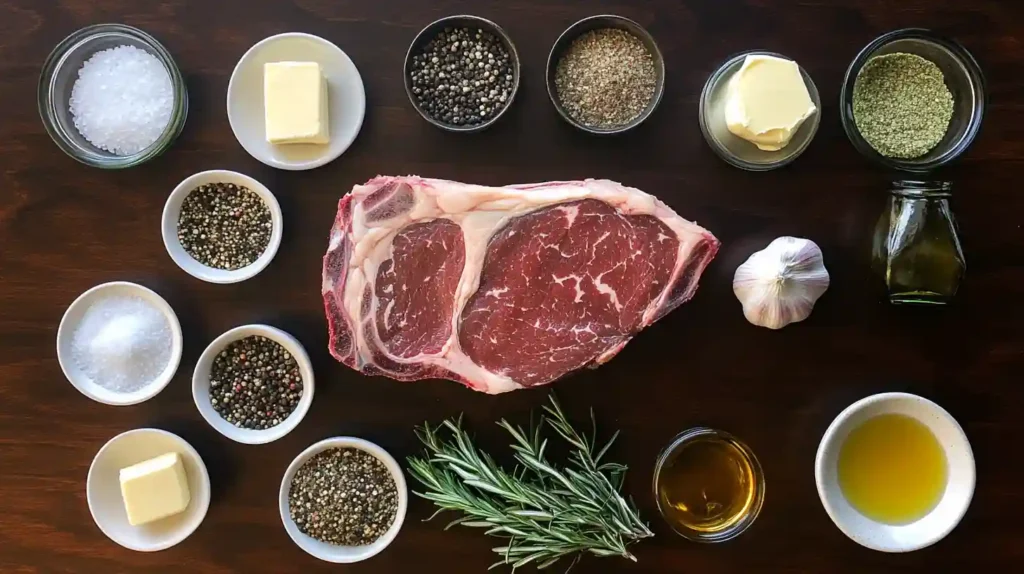
Ingredients
To achieve the perfect ribeye roast, you’ll need high-quality ingredients that enhance the natural flavor of the beef. This recipe keeps it simple yet effective, allowing the rich marbling of the roast to shine.
Main Ingredients
- 1 (4 to 6-pound) ribeye roast (bone-in or boneless) – Choose a well-marbled cut for maximum flavor and tenderness.
- 2 tablespoons olive oil or melted butter – Helps create a golden-brown crust while sealing in juices.
- 2 teaspoons kosher salt – Essential for enhancing the natural beefy flavor.
- 1 teaspoon freshly ground black pepper – Adds a subtle heat and depth to the seasoning.
- 1 tablespoon garlic powder – Infuses the roast with a rich, savory aroma.
- 1 tablespoon onion powder – Complements the garlic and enhances the umami flavor.
- 1 tablespoon dried Italian seasoning – A blend of basil, oregano, rosemary, and thyme for added depth.
- 1 teaspoon smoked paprika – Optional, but it gives a slight smokiness and enhances the roast’s color.
- 1 teaspoon mustard powder – Adds a hint of tang that balances the beef’s richness.
Optional Flavor Enhancers
- 3 cloves garlic, minced – Fresh garlic gives an extra punch of flavor.
- 2 tablespoons Dijon mustard – Adds a subtle tangy kick and helps the seasonings stick.
- 1 tablespoon Worcestershire sauce – Deepens the umami flavor profile.
- Fresh rosemary and thyme sprigs – Infuses the roast with a fragrant, herbaceous aroma.
For the Pan Drippings (Optional Au Jus or Gravy)
- 1 cup beef broth – Deglazes the pan and creates a flavorful base for a sauce.
- ½ cup red wine – Enhances the depth of the pan drippings for a luxurious au jus.
- 1 tablespoon unsalted butter – Helps create a silky texture in the gravy.
These simple yet bold ingredients come together to elevate the ribeye roast without overpowering its natural richness.
Now that the ingredients are ready, let’s move on to the step-by-step cooking instructions to ensure your roast turns out perfectly juicy and flavorful every time.
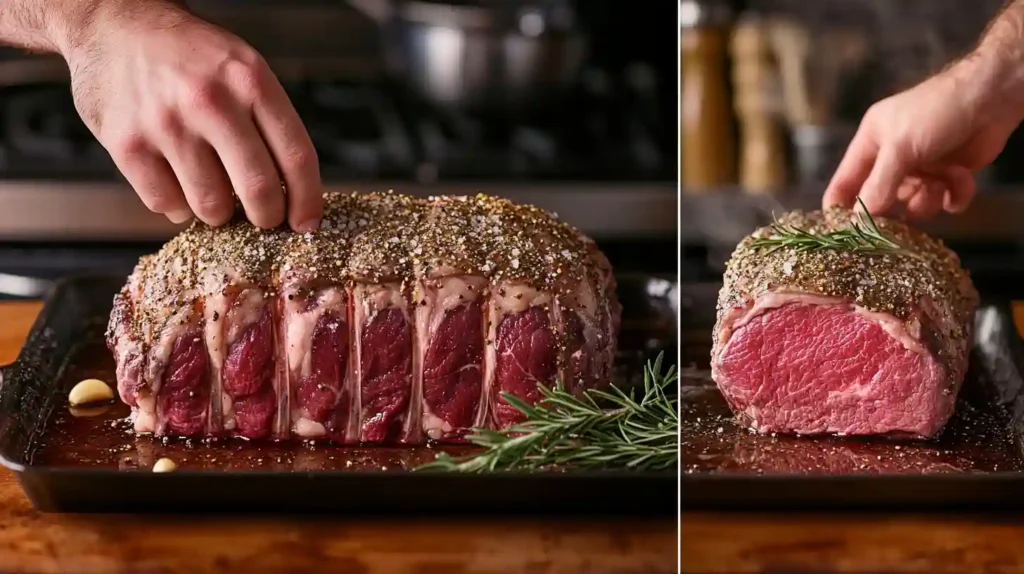
Instructions
Follow these step-by-step instructions to achieve a perfectly cooked ribeye roast with a flavorful crust and juicy, tender interior.
Step 1: Prepare the Roast
- Bring the roast to room temperature – Remove the ribeye roast from the refrigerator at least 1 hour before cooking. This ensures even cooking and a more tender result.
- Pat the roast dry – Use paper towels to remove excess moisture, which helps achieve a beautiful crust.
Step 2: Season the Roast
- Rub with olive oil or butter – Coat the entire roast with olive oil or melted butter to help the seasoning adhere.
- Season generously – In a small bowl, mix salt, black pepper, garlic powder, onion powder, Italian seasoning, smoked paprika, and mustard powder.
- Apply the seasoning blend – Rub the seasoning mix evenly over the roast, making sure to coat all sides. If using fresh garlic, Dijon mustard, or Worcestershire sauce, massage them into the meat for extra depth of flavor.
- Optional: Tie the roast with butcher’s twine – If using a boneless ribeye roast, tie it with kitchen twine at 2-inch intervals to maintain an even shape for uniform cooking.
Step 3: Preheat and Sear for Maximum Flavor
- Preheat the oven to 450°F (232°C) – A high starting temperature helps create a crisp, caramelized crust.
- Sear the roast – Place the roast fat-side up in a roasting pan with a rack. Roast at 450°F for 15-20 minutes to lock in juices and develop a deep brown crust.
Step 4: Reduce Temperature and Roast to Perfection
- Lower the oven temperature to 325°F (163°C) – This slow-roasting method ensures even cooking.
- Add beef broth or wine (optional) – Pour 1 cup of beef broth (and ½ cup of red wine, if using) into the roasting pan to enhance the pan drippings for a future sauce.
- Roast until desired doneness – Use a meat thermometer to check the internal temperature:
- Rare: 115–120°F (46–49°C)
- Medium-Rare: 125–130°F (52–54°C)
- Medium: 135–140°F (57–60°C)
- Medium-Well: 145–150°F (63–66°C)
- Well-Done: 155–160°F (68–71°C)
💡 Estimate cooking time at 20 minutes per pound for medium-rare doneness.
Step 5: Rest and Slice
- Remove the roast from the oven – Once it reaches the desired temperature, transfer it to a cutting board.
- Tent with foil and let it rest for 15–20 minutes – This allows juices to redistribute for a more tender bite. The temperature will rise by 5–10°F as it rests (carryover cooking).
- Slice against the grain – For the most tender texture, use a sharp knife to carve thin slices against the grain.
Step 6: Make the Pan Sauce (Optional)
- Deglaze the pan – Place the roasting pan over medium heat, adding ½ cup beef broth or red wine to loosen browned bits.
- Simmer for a few minutes – Stir in 1 tablespoon of butter to create a silky pan sauce.
- Drizzle over the sliced roast – Serve with your favorite side dishes.
Your perfectly roasted ribeye is now ready to impress!
Pro Tips and Variations
Achieving a perfect ribeye roast requires a few expert techniques and variations to suit different preferences. Here are some pro tips to enhance flavor, texture, and overall cooking success.
Pro Tips for the Best Ribeye Roast
1. Choose the Right Cut
- Bone-in ribeye roast retains more moisture and flavor, making it ideal for special occasions.
- Boneless ribeye roast is easier to carve and cooks more evenly.
- Look for good marbling—the more intramuscular fat, the more tender and flavorful your roast will be.
2. Let the Meat Rest Before and After Cooking
- Before cooking: Allow the roast to come to room temperature for at least 1 hour to ensure even cooking.
- After cooking: Rest the roast for 15–20 minutes, tented with foil, so the juices redistribute, keeping it moist and tender.
3. Use a Meat Thermometer
- Always check the internal temperature for accurate doneness.
- Insert the thermometer into the thickest part of the roast, avoiding bone if using a bone-in ribeye.
4. Don’t Skip the High-Heat Sear
- The 450°F (232°C) sear at the beginning creates a beautiful crust that locks in juices.
- For extra flavor, sear the roast in a cast-iron skillet before transferring it to the oven.
5. Season Generously
- Salt enhances the beef’s natural flavors, so don’t be afraid to use a good amount of kosher salt.
- Garlic, onion powder, and Italian seasoning add depth, while Dijon mustard helps the rub adhere better.
Flavor Variations
1. Herb-Crusted Ribeye Roast
- Mix chopped fresh rosemary, thyme, and parsley with minced garlic and butter, then rub it all over the roast before cooking.
- This creates an aromatic, restaurant-quality crust.
2. Garlic Butter Ribeye Roast
- Combine melted butter, minced garlic, and Worcestershire sauce, then baste the roast during the last 15 minutes of cooking.
- This enhances richness and keeps the roast extra juicy.
3. Spicy Cajun Ribeye Roast
- Swap Italian seasoning for a Cajun spice blend for a bold, smoky kick.
- Add a touch of smoked paprika and cayenne pepper for extra heat.
4. Slow Cooker Ribeye Roast
- For ultra-tender meat, cook the ribeye roast in a slow cooker:
- Sear the roast first, then place it in the slow cooker with beef broth, garlic, and onions.
- Cook on low for 6–8 hours or until fork-tender.
5. Air Fryer Ribeye Roast
- If you prefer a crispy crust in less time, roast in an air fryer at 400°F (204°C) for 15 minutes, then reduce to 325°F (163°C) until done.
- This method is faster and still delivers juicy results.
Serving Suggestions
A perfectly cooked ribeye roast deserves equally delicious side dishes to complement its rich, beefy flavor. Whether you’re preparing a holiday feast or a cozy family dinner, these serving suggestions will help you create a well-balanced and memorable meal.
Classic Side Dishes
1. Garlic Mashed Potatoes
Creamy mashed potatoes with butter, roasted garlic, and heavy cream pair beautifully with a juicy ribeye roast. They absorb the flavorful au jus or pan drippings, making every bite even more indulgent.
2. Roasted Vegetables
Oven-roasted carrots, Brussels sprouts, or asparagus add color and texture to your plate. Toss them with olive oil, garlic, and rosemary, then roast at 400°F (204°C) for 20-25 minutes until caramelized.
3. Yorkshire Pudding
A traditional pairing for a ribeye roast, these airy, golden popovers are made with eggs, flour, and beef drippings. They soak up the roast’s juices, making them the ultimate comfort food.
Lighter & Fresh Options
4. Mixed Green Salad
A crisp arugula or spinach salad with cherry tomatoes, shaved Parmesan, and balsamic vinaigrette adds a refreshing contrast to the richness of the beef.
5. Lemon Butter Green Beans
Steamed or sautéed green beans with lemon zest and garlic butter offer a simple yet elegant side that balances the deep flavors of the roast.
6. Herb Butter Dinner Rolls
Soft, buttery dinner rolls brushed with garlic herb butter are perfect for sopping up the flavorful juices from your roast.
Sauces & Condiments
7. Au Jus (Pan Drippings Sauce)
Make a simple au jus by deglazing the roasting pan with beef broth and red wine, then simmering until slightly reduced. This enhances the beef’s natural flavors without overpowering it.
8. Horseradish Cream Sauce
A tangy horseradish and sour cream sauce cuts through the richness of the ribeye roast, adding a sharp and creamy contrast.
9. Garlic Herb Butter
Melted garlic herb butter drizzled over sliced ribeye roast adds another layer of richness and flavor.
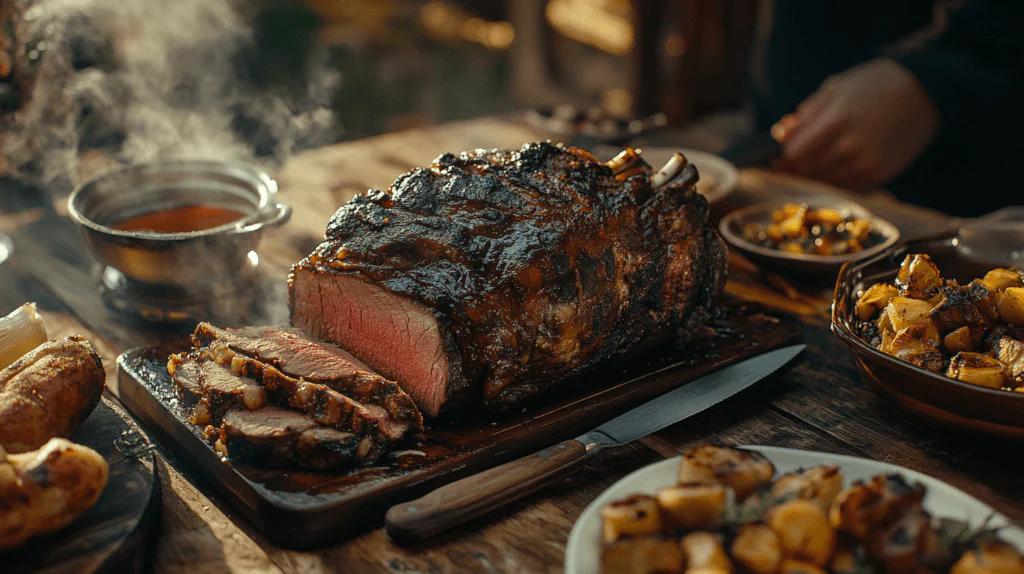
FAQs
Here are the answers to some of the most frequently asked questions about cooking a ribeye roast to perfection.
Is ribeye good for roasting?
Yes! Ribeye is an excellent cut for roasting because of its high marbling, which keeps the meat tender and flavorful. When roasted low and slow, the fat melts into the meat, creating a juicy, buttery texture with a delicious crust.
Is a ribeye roast the same as prime rib?
Not exactly. A prime rib and a ribeye roast both come from the same primal cut (the rib section), but they have some differences:
- Prime rib typically includes the bone and more fat, giving it extra moisture and richness.
- Ribeye roast can be boneless or bone-in and is slightly leaner while still maintaining incredible flavor.
Both cuts are great for roasting, but prime rib is often served as a standing rib roast, while ribeye roast is slightly easier to carve and cook evenly.
How is ribeye best cooked?
The best way to cook a ribeye roast is by searing it at a high temperature (450°F) first, then slow-roasting it at 325°F until it reaches your desired doneness. Using a meat thermometer ensures accuracy:
- Rare: 115–120°F
- Medium-Rare: 125–130°F
- Medium: 135–140°F
- Medium-Well: 145–150°F
- Well-Done: 155–160°F
Letting the roast rest for 15–20 minutes after cooking is essential for juicy results.
What temperature should a ribeye roast be cooked at?
A ribeye roast should be cooked at 325°F (163°C) after an initial sear at 450°F (232°C). This slow-roasting method ensures even cooking while preserving moisture. Always use a meat thermometer to check for doneness, as cooking time varies based on the roast’s size.
This wraps up the complete ribeye roast recipe guide! With these expert tips, variations, and serving suggestions, you’re now ready to cook a perfect ribeye roast every time. Let me know if you need any final edits before finalizing the content.
Conclusion
A ribeye roast is one of the most flavorful and tender cuts of beef, making it the perfect centerpiece for any special occasion or family dinner. With the right preparation, seasoning, and cooking techniques, you can achieve a juicy, restaurant-quality roast in your own kitchen.
By following this step-by-step guide, you now know how to:
✔ Select the best ribeye roast (bone-in or boneless)
✔ Season it properly for maximum flavor
✔ Cook it to the perfect doneness using a meat thermometer
✔ Let it rest for optimal tenderness before slicing
✔ Pair it with the best side dishes and sauces for a complete meal
Whether you prefer a classic oven-roasted ribeye, a slow cooker version, or a crispy air fryer variation, this recipe allows for customization based on your preference. With expert tips and flavor variations, you can make this ribeye roast recipe uniquely yours.
Now that you have all the tools to make the best ribeye roast, it’s time to bring this dish to life in your kitchen. Serve it with your favorite sides, enjoy the rich flavors, and impress your guests with a perfectly cooked ribeye roast.
Up next, let’s move on to Section 8: FAQs to answer the most common questions about cooking a ribeye roast. Let me know if you’d like any modifications before I proceed!



